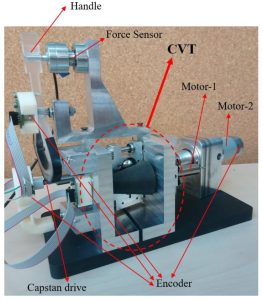| Funding Agency | THE SCIENTIFIC AND TECHNOLOGICAL RESEARCH COUNCIL OF TURKEY (TÜBİTAK) |
| Program | 1005 |
| ID/Acronym | 117M405 / HISS |
| Grant Period | 2017-2019 |
| Principal Investigator | Dr. M. İ. Can Dede |
| Project Group |
|



Aim:
In this project, by carrying out work for a new mechanism, new sub-components and model improvements in desktop haptic device technology, a device, and its sub-components are aimed developed to be used in processes that require precision such as remote surgical systems
Short Summary of the Topic:
A teleoperation system is composed of a master system on the human operator site, a slave system on the task site and a communication infrastructure between these two systems. Generally, the master system is distant from the task site and human operator by using the master system accomplishes the task via sending commands to use the slave system. Usually, the mentioned commands are motion commands and the master system is responsible for acquiring these motion commands from the human operator. Depending on the necessities of the task, the mentioned motion commands are acquired by sensing generally the hand motion and sometimes sensing the foot, leg, eye or total body movement of the human operator. In the teleoperation system, if the slave system’s physical interaction information with the task site is to be sent to the master system as force-feedback, then the master system is required to transmit this fed-back force information to the human operator. The devices that both acquire the motion of the desired limbs of the human operator and provide the force transmission to the human operator are called kinesthetic haptic devices. In this project, a haptic device will be developed to be used in teleoperation systems. Primary investigator of this project has already developed a haptic device as a result of his completed Marie-Curie International Re-Integration Grant within the European Union 7th Framework Program. In consequence of the analyses and tests carried out on this device, it is foreseen that by the design of new mechanisms, new sub-components and improvements on system modeling, a haptic device that: 1) can acquire accurate motion command even when it is providing force feedback and 2) has enhanced impedance width and transparency performance. The innovative sides of the subject that will be handled in this project are: 1) For the first time, an actuation system that provides a solution to the stiction problem in actuation systems with Magneto-Rheological (MR) fluid, 2) For the first time, as a result of using the stiffness model in acquiring the motion information from the haptic device, weight of the device’s mechanism can be decreased, 3) A passively gravity-balanced R-CUBE mechanism will be developed, 4) A device specific control card will be developed that can be used in the final product.
In what ways the targeted objectives and expected outcomes can have contributions to science, technology, and socio-economy:
In the new generation of robotic systems, human-robot interaction does not only take place in software (i.e. through a teach pendant) but happens as a physical interaction. We will increasingly come across robots that either works with the human or share the same working environment with the human. In this project, it is expected the system and sub-components that will be developed will improve the human-robot interaction and enhance the total system performance. It will be possible to employ the developed sub-components not only in teleoperation systems but also in robots that work with the human or share the same environment with the human. It is possible to use the sub-component and methodologies developed in this project in co-operative robots that will start to work on factory floors in the near future and in rehabilitation robots.
M. G. Karabulut and M. İ. C. Dede “Design and Experimental Validation of an MR-Fluid Based Brake for Use in Haptics,” ACTUATOR 2018; 16th International Conference on New Actuators, pp. 1-5, Bremen, Germany, 25-27 June 2018. Click on for Open Access Version
İ. Görgülü, G. Kiper, and M. İ. C. Dede “A Critical Review of Unpowered Performance Metrics of Impedance-Type Haptic Devices,” In: Corves B., Wenger P., Hüsing M. (eds) EuCoMeS 2018. European Conference on Mechanism Science 2018. Mechanisms and Machine Science, Vol. 59, pp. 129-136, Springer, Cham. (DOI: 10.1007/978-3-319-98020-1_15) Click on for Open Access Version
E. Mobedi, İ. Görgülü, and M. İ. C. Dede “Experimental Evaluation of Actuation and Sensing Capabilities of a Haptic Device,” In: Corves B., Wenger P., Hüsing M. (eds) EuCoMeS 2018. European Conference on Mechanism Science 2018. Mechanisms and Machine Science, Vol. 59, pp. 137-144, Springer, Cham. (DOI: 10.1007/978-3-319-98020-1_16) Click on for Open Access Version
İ. Görgülü and M. İ. C. Dede “Computation Time Efficient Stiffness Analysis of the Modified R-CUBE Mechanism,” In: The International Conference of IFToMM ITALY (pp. 231-239). Springer, Cham. November 2018. Click on for Open Access Version
İbrahimcan Görgülü “Optimal design of a kinesthetic haptic device mechanism for enhancing its impedance characteristics,” MSc Thesis, Izmir Institute of Technology, 2018.
